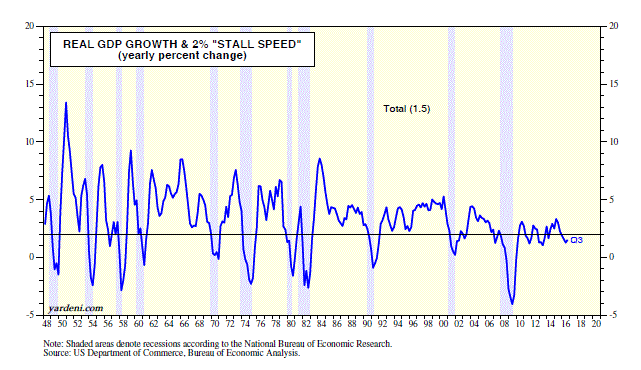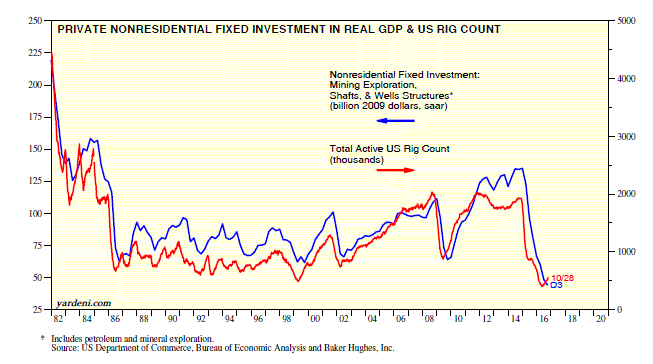In the movie “Casablanca,” Humphrey Bogart tells Ingrid Bergman, “Ilsa, I’m no good at being noble, but it doesn’t take much to see that the problems of three little people don’t amount to a hill of beans in this crazy world.” Apparently, the US exported a hill of soybeans during Q3. A surge in soybean exports after a poor soy harvest in Argentina and Brazil helped to shrink the US trade deficit during the quarter, boosting real GDP growth.
I prefer to track the trend in GDP by monitoring the y/y growth in this key indicator of economic activity. Real GDP continues to grow in the US, though it is doing so at a slower pace. While it rose 2.9% (q/q saar) during Q3, up from 1.4% during Q2, it was up only 1.5% compared to a year ago. That’s below the 2% “stall speed” that led to recessions in the past. However, this time has been different, so far. Economic growth has been fluctuating around 2% since Q1-2011 without actually stalling.
The Latest Numbers:
(1) Government is no longer a drag. From mid-2010 through mid-2014, real GDP excluding federal, state, and local government spending rose mostly around 3.0% on a y/y basis. However, since Q4-2015, real GDP growth has been below 2.0% with and without government spending. In other words, government spending has stopped weighing on growth over the past year.
(2) Energy recession is over. Of course, the biggest drag on growth since the second half of 2014 has been the recession in the oil patch. Real GDP spending on mining exploration, shafts, and wells structures plummeted 67% from Q4-2014 through Q3 of this year. This is very similar to the plunge in the mid-1980s, when the oil business fell into a recession yet the overall economy continued to grow. This series is highly correlated with the US rig count, which seems to have bottomed at the beginning of this year.
The energy recession also depressed demand for trucks and railcars to transport fracking materials and crude oil. That has been reflected in the 10% y/y drop in real outlays on transportation equipment. This category of capital equipment had soared to record highs over the previous few years. While there may be more downside in this series, it was encouraging to see sales of medium-weight and heavy-weight truck sales rebound sharply during September.
Meanwhile, the energy recession hasn’t depressed capital spending elsewhere. Real spending on industrial equipment, information processing equipment, software and R&D all edged up, remaining in record-high territory during Q3.
(3) Obamacare may be weighing on consumers. Consumer-spending growth slowed from 4.3% (q/q saar) during Q2 to 2.1% during Q3. This series, which is also available monthly, showed a solid y/y gain of 2.6% during August. However, that was down from a recent peak of 4.0% during January 2015. An increasing drag on overall consumer spending may be Obamacare. The Affordable Care Act has driven up costs throughout the entire health care system. Out-of-pocket spending on deductibles and copays has risen sharply. Since consumers can’t predict their health care needs, this also creates a great deal of uncertainty and anxiety about how much should be set aside for these increasingly unaffordable out-of-pocket expenses.
Another possible drag on consumer spending is that the economy may be at full employment. While job openings are at a record high, finding workers with the skills to fill the openings is getting harder. So employment growth could slow because of a labor shortage. That should, in theory, boost wages, but it hasn’t happened yet.
(4) Inventory drag over for now. Real inventory investment has been a negative contributor to real GDP growth for the past five quarters through Q2. During Q3, it contributed 0.61ppt of the quarter’s annualized growth in real GDP. Again, I suspect that the energy recession may have weighed on inventories since mid-2014, when the price of oil took a huge dive. That effect may finally be behind us.
(5) More than just a hill of beans. The soybean-driven export growth spurt is likely to reverse in Q4, though exports of capital and consumer goods have been growing strongly in recent months. Overall exports increased 10% (q/q, saar), the biggest rise since Q4-2013. As a result, trade contributed 0.83ppt to GDP growth after adding a mere 0.18ppt in Q2. The strength of the dollar and slow global economic growth suggest there won’t be any more upside surprises in exports anytime soon.
(6) Waiting for the Millennials. During one of my meetings in Boston at the end of last week, I was asked what might cause a sustainable upside surprise in real GDP growth. I responded that I am waiting for the Millennials to get married, move to their own homes in the suburbs and have kids. I may be waiting for a while. There’s some, but not much, evidence that they’ve started to settle down the way the Baby Boomers did.
The Bottom Line
So my central premise is that the slowdown in real GDP growth since mid-2014 was mostly attributable to the energy recession, which seems to be over. If so, then the economy should resume growing at its stall speed of 2% without stalling into a recession.


